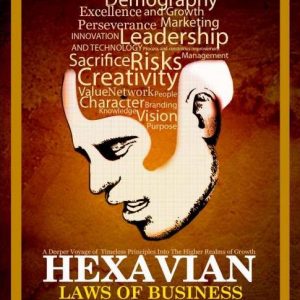The 7 Habits of Highly Effective People, by Stephen R. Covey, has been a wildly successful book that has received both national and international acclaim. It has sold over 15 million copies. The simplicity of its language in expressing profound truths have led the book to be dubbed, “simple, but not simplistic” by critics and reviewers.

The 7 Habits of Highly Effective People attempts to be a paradigm changer. It attempts to shift the focus of individual and corporate thinking from several paradigms of ineffectiveness to paradigms of effectiveness. A few examples being changing the focus from efficiency to effectiveness first; from management to leadership first; from personality development to character development first. Stephen Covey in The 7 Habits of Highly Effective People strongly asserts that when we put first things first, every other thing that needs to fall into place would fall into place.
The book is written in two parts: the first part covered, Principles of Personal Leadership, and dealt with the need to be proactive, painstakingly visionary in planning and execution, and prioritize well. The second part dealt with the need to understand people’s view point before we seek understanding of our own, thinking “win-win” rather than “win-lose” or any other ineffective paradigm, and building synergistic capacity both in individuals and teams. A third mini-part focused on wrapping it all up with what Covey called Sharpening the Saw, which talked about renewal spiritually, physically, mentally and emotionally. These were well covered in 7 main Chapters, excluding the excluding the introductory chapter that dealt with growth from in inside-out rather than outside-in which is the more conventional approach.
INSIDE OUT: In the Introductory chapter, Covey focused strongly on the change paradigm, and how people attempt to force superficial changes on themselves and their situations by changing their behaviours rather than their attitudes, which causes and drives their behaviours. He stressed that the effective way to change would be to change paradigm, which can be loosely seen as a person’s point of view or perception of a matter, his mind frame towards something. Steven Covey also spoke about the undue focus on Efficiency in organizations, rather than effectiveness, and how it had affected corporate America poorly. He explored this with respect to Personality and Character ethic, where people focused on appearing likable, charming, and charismatic, rather than being loyal, honest, dependable and people of integrity. He said that this failure to change from Inside Out had been the bane of successful corporate and relationship life, as people seem to always look for quick fixes and there aren’t any quick-fixes in the drive for effectiveness.

CHAPTER ONE: BE PROACTIVE
The first step in achieving effectiveness would be to Be Proactive. This means beings not just being responsible or in charge of situations but ASSUMING THE PARADIGM that makes it impossible for one to blame any external circumstances for the way things happen in their lives. Being proactive rather than reactive simply means that a person centres the blame/responsibility for all the outcomes happening around his life upon himself, and then he begins to look for what he must change or improve, rather than blaming people and external circumstances and trying to impose change on them.
There are certain paradigms that encourages being proactive. The paradigm of being, for instance rather than having. We should change from external blames into internal decisions and use proactive-action driving statements, focusing on CHOICE. He said
that people choose what they BECOME or how they ACT, in the quick-short space between ACTION and REACTION. Therefore, we could choose to be more affirming, more dependable, more loving rather than saying things like (PARADIGM OF REACTIVITY) If my father loved us, I would HAVE loved my family. Or, if only I was paid better, I would HAVE been a better employee.

True character is not dependent on external circumstances, and he was bringing people to understand that once they operate on the Paradigms of effectiveness, by focusing on things they can control (by acting right on them) then the things out of their control would eventually come under their controls. This he called Circle of Concern, for external situations that we don’t have control over and Circle of Influence, for internal situations that we have control over.
CHAPTER TWO: BEGIN WITH THE END IN MIND:

Stephen Covey said that all things are created twice, first in the imagination and then in reality. Using the architectural drawing for a house, he described the process of the first creation, and the painstaking details it takes to ensure that everything is in its place from the start, stressing that once this initial work isn’t done right, a person is likely to fail in the second creation. This is because, the first creation is the plan, and the second creation is our execution of the plan and bringing it into reality.
He was saying in essence that when we want something in reality, we should take time to painstakingly create what we want in planning and imagination, and leave nothing to chance. He ended this chapter up with exercises, asking people to draw up the kind of live they want to live and how they wanted to be remembered after death to drive home his point and give them perspective on the matter.
CHAPTER THREE: PUT FIRST THINGS FIRST.
Dr. Covey in Chapter Three emphasized the need for us to put first things first, that means to prioritize, know what these priorities are and live truthfully to them. He talked about being centred in this chapter, which is synonymous with being driven. He talked about people that are success centred, family centred, relationship centred, enemy centred, and etcetera. According to him, when a person is centred around something, it drives all his behaviours and attitudes and actions. Putting first things first, means that a person changes every other ineffective paradigm that drives him/her and focused on being Principle Centred, which means to be driven by his deepest and truest values, rather than to be turned like the hinges of a door.

He gave the Life Purpose Statement, as an exercise tool to enable people determine what is most important to them and advised on how we can organize our lives around our values to live out our true purposes.
He also spoke in this chapter of Time Management, which he called a misnomer, because according to him, time cannot be managed, but our lives can be managed to make the most out of time. We achieve this by focusing on the SECOND QUADRANT, which is the quadrant of effectiveness, to work on reading, learning, growing, and doing the right things, rather than working on the URGENCY QUADRANT (1), or the QUADRANT 3 and QUADRANT 4 which are quadrants of waste and inefficiency.
PART TWO: This dealt with interpersonal relationships as a build up on the focus on character and development of personal integrity with oneself.
CHAPTER FOUR: SEEK TO UNDERSTAND RATHER THAN BE UNDERSTOOD
Chapter 4 focuses on the need to understand people first, their paradigms, where they are coming from, what their unique perspectives on a matter is, rather than try to force our paradigms on them. It believes that we have more potentials and chances of changing people by changing the way we listen rather than attempting to change them by proselytising or “preaching” to them. He insists that people want to be understood, and until that is achieved that they don’t care to understand whatever we want to make them understand.

To achieve this, he taught the process of empathetic, non-judgmental listen which focuses on the feelings of the persons – not the rationality of his statements, not our prejudices, not what he’s saying (which can be misleading), but his feelings. It’s very much like reading between the lines, with the hope of establishing a connection between the listener and the person listening. When this is achieved, he said, the person listened to, feeling understood and is in better position to reciprocate this rare gesture by understanding the perspective of his listener.
This, he asserted, would be a major change from ineffectiveness to effectiveness in relationships.
CHAPTER FIVE: THINK WIN-WIN
In this chapter, he stressed that human relationships eventually leads to points where we want to have/do something, while our other wants something different. This leads to some kind of negotiation to determine who gets what. People usually used or did this the wrong way, focusing on Winning for themselves, and not for the relationship. He called this Win-Lose relationship. He also told us about other ineffective paradigms of competition like Lose-Win, and Lose-Lose relationships, but stressed that the Win-Win relationship is the most effective and doesn’t only give you want you want in the short term, but preserves relationships in the long term.

The way to achieve this would be to search for NOT your way, OR the other persons way, but that TOGETHER, by WIN-WIN discussions, both parties search for the HIGHER WAY or the THIRD ALTERNATIVE, which usually would be neither or either parties full wishes, but a blend of both which is usually more refreshing and sustaining to the relationship.
CHAPTER SIX: SYNERGIZE
Chapter Six focused on the need to synergise. This means to create effective relationships with the end of focusing our energies and ideas intently together, so that our end result is more than the sum of our parts. It involves working together, in harmony, and blending together ideas, experiences and perspectives to create a greater, higher idea that is greater than the sum of what any person would have individually brought to the table. This is synergy and synergistic relationships are far more productive than the others, and when used right can bring about great levels of success/solutions that wouldn’t have been possible working out singularly by anybody.

CHAPTER SEVEN: SHARPENING THE SAW
Chapter Seven dealt with the concept of working from the inside out again, focusing on sharpening the saw to achieve success in career, life and relationship. He spoke about focusing on four key areas. Physically, by working out and exercising to restore the body; Mentally, by learning, studying and interacting with intellectual materials to develop the mind; Emotional, by listening to music, spending time with loved ones and family to develop the heart and relationships, and finally, Spiritually, spending time in prayer and study of spiritual literature to develop the spirit.

This would make for a well rounded and highly effective person.
Reviewed by Amarachi for Hexavia!




1 comment